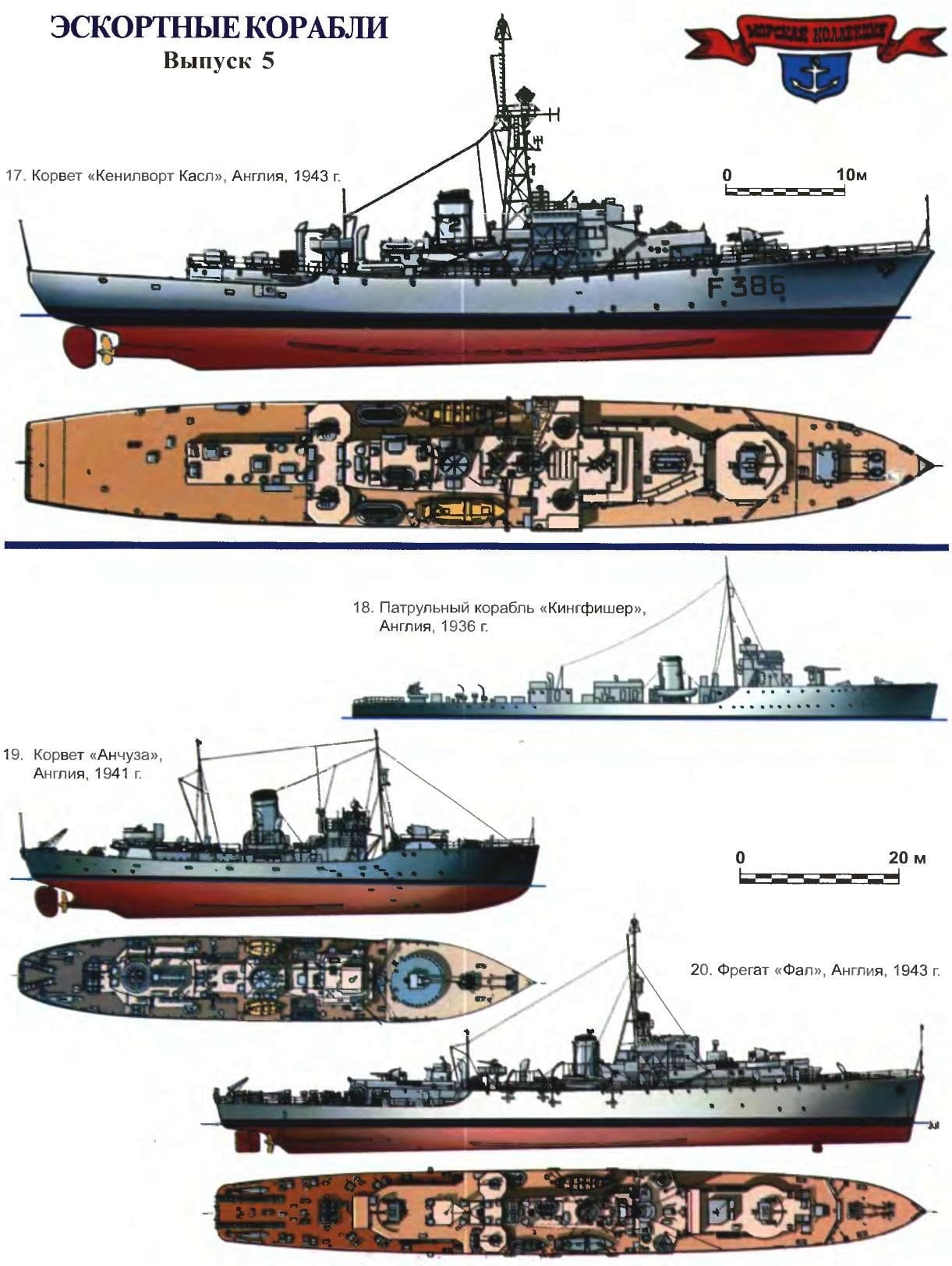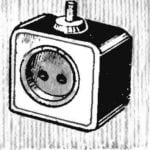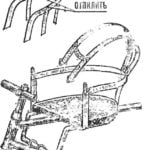 Not to say that after the First world war, the British did not think about the problems of a future war, but their reasonable ideas are embodied in a metal surprisingly slowly. For example, the Admiralty issued an order for a new patrol and guards of the court only after their predecessors came almost to a complete standstill, having exhausted their resources. As a result, by the time of Hitler’s attack on Poland “mistress of the seas” had only six small patrol ships of the “Kingfisher”, and three were in the same building.
Not to say that after the First world war, the British did not think about the problems of a future war, but their reasonable ideas are embodied in a metal surprisingly slowly. For example, the Admiralty issued an order for a new patrol and guards of the court only after their predecessors came almost to a complete standstill, having exhausted their resources. As a result, by the time of Hitler’s attack on Poland “mistress of the seas” had only six small patrol ships of the “Kingfisher”, and three were in the same building.
And again, the war hit the British fleet, as snow on the head. Again, as in the First world, the main problem was the German submarines. Small sloops and patrol boats could not cover all the sea routes in the waters of the great Empire. In addition, for mass production they did not fit. The sloops were too expensive, and 102-mm twin anti-aircraft guns lacked for other, larger ships. “Kingfisher” was too small for ocean service, and turbine mechanisms for it demanded well-equipped factories and highly skilled workers. And again, the situation a quarter century ago was repeated almost exactly. On stage again was a universal escort ships bearing the names of colors and therefore again referred to as “Flows”.
However, over the past 25 years the possibility of Britain declined markedly. Quickly start mass construction of anti-submarine ships with a little bit of modern characteristics have already failed. Had to reduce ambitions and to use as the basis for the project, a modest whaling “southern pride”, built by “Smith, Doc.” Sturdy but clumsy hull (length-width ratio only slightly exceeded 5:1) lengthened by 10 m, extended in the stern and forecastle expanded bridges and cuttings, providing them with a light anti-bullet armor. To the sailors could keep the strength to fight, the interior was supplied with artificial ventilation and a normal electric lights, which were deprived of their civilian counterparts. That creature became the progenitor of a new class of ships, nostalgically called corvettes by analogy with auxiliary sailing vessels, “the masters of all trades” in the time of Nelson, Jervis, and Hood.
Despite all attempts to make civil ship warship, his whaling pedigree shone in huge for such a small hull lees, which made the “flower” vulnerable target for torpedoes (no wonder almost all the dead during the war were victims of this weapon). In case of accident or damage to the only steam engine hunter turned into a helpless target that was tough even for artillery submarine. Short wide case predetermined low speed Corvette, which he is ill suited for chasing submarines, especially in the open Atlantic.

17. Corvette “Kenilworth Kweli”, England, 1943
Built by “Doc Smith”. The standard displacement of 1060 tons, full 1610 T. maximum Length 76,81 m, width of 11.19 m, draft 4,15 m. Capacity single-shaft steam triple expansion installation, 2750 HP., speed 16.5 per node. Armament: one 102-mm gun, six 20-mm machine guns, rocket-propelled mortars “Squid”. Just 1943-1945 built 44 units.
18. Patrol ship “Kingfisher”, England, 1936
Built by the firm “Fairfield”. Displacement 520 t standard, full 745 T. maximum Length 74,14 m, width of 8.08 m, draft 2,44 m. Capacity twin-shaft steam turbine 3600 HP, speed 20 knots. Armament: one 102-mm gun, 50 depth charges. Just 1935-1939 was built nine units.
19. Corvette “Anchusa”, England, 1941
One of a series of ships of the type “Fpower”. Built by “Harland & Voph”. The standard displacement of 950 tons, 1170 normal t full t 1320 maximum Length of 63.5 m, width of 10.11 m, draught 4,35 m Capacity single-shaft steam installation 2750 HP, speed 5 knots. Armament: one 102-mm gun, 40 depth charges. Just 1940-1944 in England and Canada built 247 units.
20. The frigate “FAL”, UK, 1943
One of a series of ships of the “river”. Built by “Doc Smith”. The standard displacement of 1360 tons, full 2080 t Length overall 91,84 m, width: 11,18 m, draught 3,73 m. Capacity twin-shaft steam triple expansion installation 2750 p. S., speed of 16.5 knot. Armament: two 102-mm guns, four 20-mm machine gun, rocket-propelled mortars “Hedgehog”. Just 1943-1945 in England, Canada and Australia built 131 unit.
However, the “flowers” had such obvious advantages as low cost, ease of manufacturing, good maneuverability and adequate supply of depth charges. However, the space for extra weapons is clearly lacking. The most that has been done since 1942 installing one 40-mm “POM-POM” and a pair or two light 20-mm “zlichov” and “Hedgehog”— the first jet ASW mortars. The last was not too effective, but in the early and mid-war was considered a very promising weapon.
Meanwhile, it was becoming obvious that a purely “whaling” project has exhausted its possibilities. And then the chief engineer of the same company “Doc Smith” William Reid has developed a new project. Proposed extended another 13 m (while maintaining the width) hull with extended forecastle and significantly raised the bow is much better suited for action in heavy seas. Corvettes of the series “castle” have received the names of English, Scottish and Irish castles, which looked more like warships than their predecessors. The main advantage was the installation of the latest anti-submarine weapons — reactive mortars “Squid”.
A salvo of three heavy depth charges exploding at different depths when covering would leave the submarine much of a chance, unlike the scattering of small bombs “Hedgehog”, besides sabatinovka only in direct contact. No wonder “Squid” remained the main anti-submarine weapon for quite a long time after the war. And superficially “castle” had a much more solid feel — mostly due to the impressive lattice masts, carrying search radar and direction finder.
But for all its positive qualities, the corvettes had only limited application. To accompany transatlantic convoys lacked range, and long service in the open ocean greatly exhausted command. No wonder almost simultaneously with the creation of the “flower” series, the Admiralty ordered the project to larger escort vessel.
The main conditions become the maximum cheapness and unification with the corvettes. The latter was achieved through the use of the same steam engines triple expansion, but in twice the number. Also doubled the number 102-millimetrovogo. As the main anti-submarine weapons installed best that there was in 1941 — the “Hedgehog”. Significantly increased the supply of conventional depth charges reached a hundred.
So there is another class of escort ships, whose name was also returning from the era of sailing ships, — frigates. The first series was designated “the river” (“River”): all units bear the names of rivers of great Britain — the country in General, rivers are not rich. Since the number of ships was approaching the hundred, “embodied” in the metal was even quite a small river.
A very successful first frigates nevertheless not fully satisfy the requirements of sailors. The fuel supply was insufficient, and designers had to abandon the Central equipment, and to redesign the cabin and the pantry. The result has been to increase the capacity of oil tanks in 1.5 times— up to 650 tons, which allowed not only to cross the Atlantic without refueling, but also to the active search and pursuit of submarines at high speed.
To the British “rivers” were soon added the canadian. Easy to manufacture, dozens of ships were laid at the shipyards of the dominion overseas. Canadians are not only faithfully reproduced the project, but stepped up weapons, replacing a single-chetyrehmetrovy on the two-gun installation, in addition to which some of the frigates were mounted and 76-mm antiaircraft guns. Until the end of the war in Canada was built the same “Reavers” as in the UK, and order another 20 had to be cancelled in connection with the termination of hostilities. All in all, the dominion was able to put almost half of the escort ships produced for the war in the British Empire, often with stronger weapons and better equipment.

21. The frigate “Loch moor”, England, 1944
Built by “Caledon”. Displacement standard, t 1435, t 2260 full Length the greatest 93,57 m, width of 11.76 m, draft 3,76 m. Capacity twin-shaft steam install throne expansion to 5500 HP, the speed is 19.5 knot. Armament: one 102-mm gun, four 40-mm machine gun, two rocket mortar “Squid”. Only in 1944-1945. built 28 units.

22. Frigate “Wilmut Bay”, England, 1944
Built by “Harland and Wolff”. The standard displacement of 1585 tons, full 2420 T. maximum Length 93,7 m, width of 11.76 m and draught of 3.8 m. Capacity twin-shaft steam triple expansion install 5500 HP, the speed is 19.5 knot. Armament: four 102-mm guns, four 40-mm gun, reactive mortars “Hedgehog”. Just 1944-1948 was built 21 units.

23. Escort destroyer “Brecon”, England, 1942
Belonged to the series “the hunt 4”, built by “Thornycroft”. The standard displacement of 1180 tons, the complete 1590 T. maximum Length 90,2 m, width of 10.15 m, draft 2,43 m. Capacity twin-shaft turbine installation 19 000 HP, speed 25 knots. Armament: six 102-mm universal guns, four 40-mm and two 20-mm machine gun, two mortars and the release gear for depth charges. Only in 1942, built two units: “Brecon” and “Biseinen”.
I must say that Canadians are not too strictly followed the English tradition of naming, giving its ships names and rivers and mountains and towns, and bays. But in Australia, a country almost devoid of large rivers, there were still a dozen proper names. The Australian “Gascoigne”, and his sistership also wore a pair of 102-mm guns, but unlike the canadian frigates, not a Sparky, and two single units on bow and stern.
Quite satisfactory design “Rivera” still lacked the most important thing — more powerful anti-submarine weapons. At that time it simply was not. But by the end of 1943 arrived, promising “Squid”, and the designers had to rework the drawings.
Slightly increased in the case managed to place two rocket mortars. At the same time, engineers have managed to simplify the design itself, so that sections of buildings could now be manufactured in factories and then assembled at the shipyard.
This technique, borrowed from the Americans, allowed to build escort ships even faster. Thanks to her a big part of the new series “the Loch” received the names of lakes in the UK (because of geography — exclusively Scottish), had to be launched before the end of the war.
A relatively weak place new convaincu remained defense. Their armament was increased by four-barrel “POM-POM”, not too quoted at the end of the war and not enough artillery to cover the escorted ships. More useful for defensive fire chetyrehmetrovy was still in short supply.
Only to the end of the war, when the British were gathered together with the “senior partner” to storm the island of Japan, it was decided to create a convoy ship with more pronounced “anti-aircraft” designation. As the platform was a good fit of the generic “lake” case. It installed two 102-mm anti-aircraft Sparky and the same number of modern 40-mm double-barreled “botrov”, supplemented by another two or four and several single-barreled 20-mm “slicename”. It turned out a kind of ship air defense (pre-war destroyer!), have lost much of their anti-submarine relics, presented now only a single “Hedge hogom”.
In principle, the state of Affairs in the oceans in 1945, it is allowed to make such a decision. The main enemy now saw not a German submarine, and the Japanese “kamikaze”. It is difficult to say how the type “Bay” (“Bay”) would be able to meet the expectations of: the war is over, and half of the two dozen former “lake” of the buildings being completed on a new project after the end of hostilities. Some of them were rebuilt in the messengers and rescue vessels still on the stocks.
Such, in General, a positive note ended the development of British escort forces during the Second world war. If not immediately, but managed to create quite capable of specialized types of escort ships and organize their mass production. However, compared to Americans and effort, and the results looked quite modest.
Concluding the description of the military history then still a great Imperial Navy, it should be noted that the British had not abandoned the idea of creating an escort of destroyers. Interestingly, the prototype for the project were that net patrol — the sloops of the “black Swan”.
A very ambitious initial version was too complicated for its 800 tons of weapons eliminated the only thing that would allow future ship called the destroyer,— four torpedo tubes.
Already during the construction of the “hunt” of the first series has lost a third of artillery — one of the three 102-mm anti-aircraft Sparky.
On the second series of escort destroyers managed to restore the status quo with artillery, increasing the width of the body (and therefore stability) of the overloaded ship. On the contrary, in the third series returned to the armament of torpedo, leaving only two artillery systems.
Such vacillation from artillery to torpedoes and back is very characteristic of the shipbuilding policy of England at the beginning of the Second world war. To some extent this is explained by quite objective reasons: this period is not clear how it will develop further events on the seas.
Equally characteristically, the most successful and appropriate almost all the requirements of escort destroyer of the “hunt-4” managed to build only to the middle of the war. It should be noted that it is based on a project developed in 1938 and then rejected as insufficiently fast.
Long forecastle (like all frigates) provided good seaworthiness and a large useful volume of the premises, and the weapons included three 102-mm twin anti-aircraft guns and three-pipe torpedo tubes. However, the inevitable price to pay for all the improvements was the reduction of speed to 25 knots — it is diminished by about two knots compared to previous series.
However, much more expensive than the cost the fact that at the time of the entry into operation of the first two (and only) “hunt” acute need for them anymore.
Almost all the problems of war at sea, including those associated with escorting convoys and cover landings, have managed to solve mainly due to the US — the “little brother” suddenly became a “senior”.
V. KOFMAN



